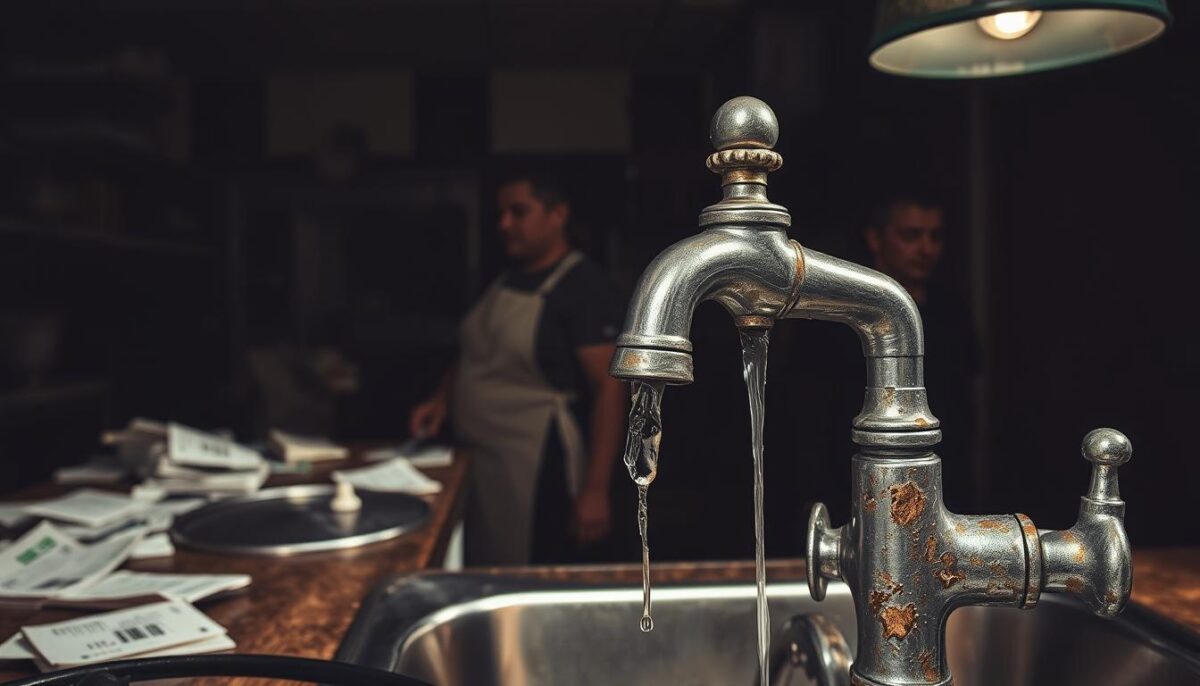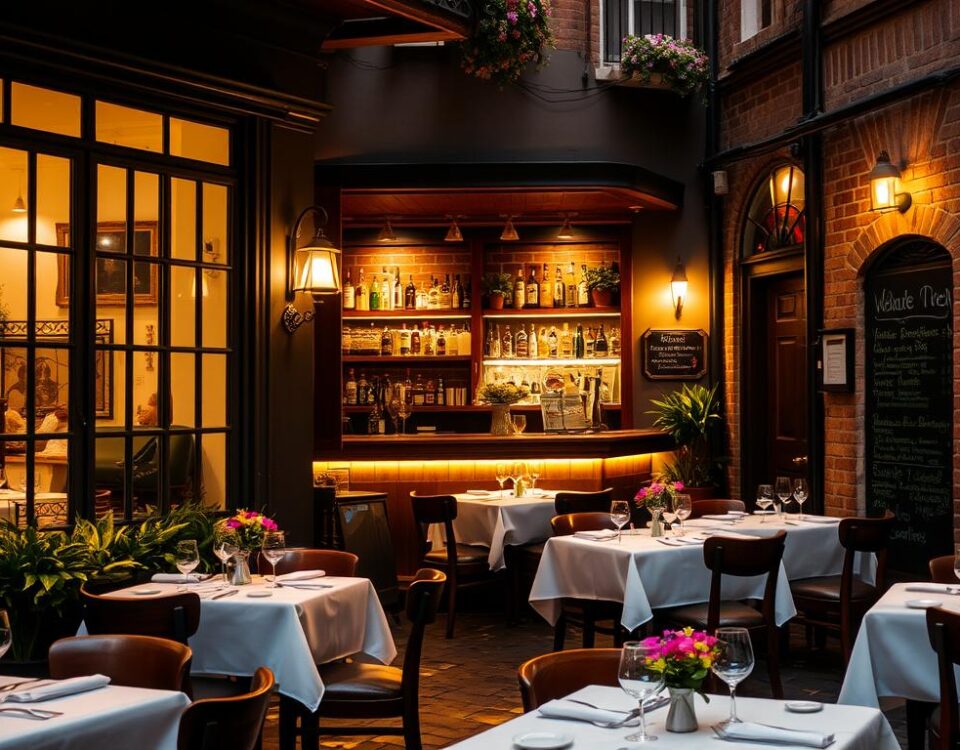
6 Hidden Expenses That Are Killing Your Restaurant Profits
July 16, 2025
How Independent Restaurant Owners Can Compete on a Franchise Budget
July 17, 2025As a seasoned expert in the restaurant industry, I’ve seen firsthand how a problematic supplier can disrupt a business. A friend’s restaurant once faced a crisis when their primary food supplier failed to deliver fresh produce on time, resulting in a significant loss of customer trust.
Did you know that a staggering 60% of business failures in the food industry can be attributed to poor supplier relationships? This statistic highlights the critical importance of identifying supplier red flags early on.
By being aware of the warning signs, you can avoid costly mistakes and ensure a smooth operation. So, what are the key indicators that a supplier is not the right fit for your restaurant business?
Key Takeaways
- Understand the critical role of supplier relationships in your restaurant’s success.
- Learn how to identify supplier red flags early to avoid costly mistakes.
- Discover the impact of poor supplier partnerships on food quality and customer satisfaction.
- Find out how to maintain successful operations by avoiding problematic suppliers.
- Gain insights into the importance of due diligence in supplier selection.
The Critical Role of Suppliers in Restaurant Success
Restaurant owners often overlook the importance of suppliers, but they are the backbone of any successful dining establishment. Suppliers are crucial in determining the quality of food, the reliability of deliveries, and the overall profitability of a restaurant business.
Why Supplier Relationships Make or Break Your Restaurant
Strong supplier partnerships can give restaurant owners a competitive edge through consistent quality, reliable delivery, and favorable pricing. This, in turn, affects customer satisfaction and ultimately, sales revenue.
The Hidden Costs of Poor Supplier Partnerships
On the other hand, poor supplier relationships can lead to increased costs, including emergency orders, food waste, and disappointed customers. These issues can ripple through the entire restaurant business, affecting kitchen operations, menu planning, and ultimately, revenue.
By understanding the critical role of suppliers, restaurant owners can take steps to build strong relationships, reduce expenses, and improve food quality, ultimately leading to a successful restaurant.
Understanding Restaurant Supplier Red Flags
The success of your restaurant heavily relies on your ability to identify and address supplier red flags. These warning signs can indicate potential problems in your supply chain that, if left unchecked, could lead to significant issues for your business.
What Constitutes a Red Flag in the Restaurant Supply Chain
A red flag in the restaurant supply chain refers to any indicator of a potential problem with your supplier. This could include inconsistent quality of food deliveries, suspicious pricing structures, or poor communication. For instance, if a supplier consistently fails to meet delivery deadlines or provides products that do not match your quality standards, it’s a sign of a larger issue.
How Red Flags Impact Your Bottom Line
Red flags can directly affect your restaurant’s bottom line by increasing costs and reducing sales. For example, if a supplier provides low-quality ingredients, it could lead to customer dissatisfaction, negative reviews, and ultimately, a loss in sales. Moreover, the time and resources spent addressing these issues take a toll on your business, further impacting your bottom line.

Red Flag #1: Inconsistent Quality and Delivery
Restaurant owners need to be vigilant about suppliers who exhibit inconsistent quality control and unreliable delivery practices. A restaurant’s success depends heavily on consistent quality and reliable delivery from its suppliers.
Signs Your Supplier’s Quality Control Is Failing
When a supplier’s quality control is failing, it can manifest in various ways, including inconsistent product sizes, varying freshness, and fluctuating food quality. These inconsistencies can significantly impact your menu planning and food preparation processes.
The Ripple Effect of Unreliable Deliveries
Unreliable deliveries from suppliers can create a ripple effect throughout your restaurant’s operations. For instance, inconsistent delivery times can disrupt kitchen operations, forcing restaurants to maintain higher inventory levels, which in turn increases food costs and waste. Moreover, delivery timing issues can compromise your ability to serve menu items consistently, ultimately affecting customer satisfaction and sales.
To mitigate these risks, it’s essential to document quality issues effectively and address them with your supplier promptly. Consistency is the foundation of restaurant success, and suppliers who can’t deliver it consistently are a major red flag.
Red Flag #2: Suspicious Pricing Structures
Restaurant owners need to be vigilant about supplier pricing, as hidden fees and unexpected charges can erode profit margins. Suspicious pricing structures are a significant red flag that can impact a restaurant’s bottom line and overall business profitability.
Suppliers play a critical role in the success of a restaurant, and their pricing strategies can directly affect your expenses and cash flow. It’s essential to scrutinize your supplier agreements and invoices to identify any pricing anomalies.
Hidden Fees and Unexpected Charges
Hidden fees and unexpected charges are common practices used by unscrupulous suppliers to increase their sales at the expense of your restaurant’s expenses. These can include delivery fees, service charges, or other add-ons that weren’t initially disclosed. To avoid these surprises, it’s crucial to:
- Carefully review your contracts and invoices to identify any additional fees.
- Negotiate transparent pricing with your suppliers, ensuring that all costs are clearly outlined.
- Track your order history to spot any inconsistencies in pricing.
Price Fluctuations Without Clear Justification
Price fluctuations without a clear justification can make it challenging to budget and set menu prices. Sudden price increases can strain your cash reserves and impact your business profitability. To manage this risk, it’s vital to:
- Analyze market trends to understand if price changes are justified.
- Communicate with your suppliers to understand the reasons behind price fluctuations.
- Consider renegotiating your contract or seeking alternative suppliers if price increases are not justified.
By being aware of these potential red flags and taking proactive steps, restaurant owners can protect their business from unnecessary costs and maintain a healthy supply chain.
Red Flag #3: Poor Communication and Customer Service
Poor communication from suppliers can be a significant red flag for restaurant owners. Effective communication is crucial for smooth operations, especially during busy periods. When suppliers fail to respond to concerns or provide timely updates, it can disrupt the entire supply chain.
When Suppliers Don’t Respond to Concerns
Delayed responses or unanswered queries from suppliers can lead to inventory shortages and menu compromises. For instance, if a supplier doesn’t respond to a query about a delayed shipment, it can impact the restaurant’s ability to serve its customers. As a restaurant owner, it’s essential to have suppliers who are responsive and proactive in their communication.

The Value of Transparent Supplier Relationships
Transparent supplier relationships are built on mutual respect and clear communication. Good suppliers serve as industry partners, sharing market insights and helping restaurant owners navigate challenges. By establishing clear communication channels, restaurant owners can prevent misunderstandings and ensure a smooth business operation. This way, both parties can work together effectively, saving time and improving overall efficiency.
Red Flag #4: Lack of Proper Documentation
As a restaurant owner, I’ve learned that proper documentation from suppliers is crucial for avoiding trouble with health code violations and other compliance issues. Ensuring that your suppliers have the necessary documentation is not just a matter of regulatory compliance; it’s also essential for protecting your business and maintaining customer trust.
Missing Health Certifications and Compliance Records
Legitimate food suppliers should readily provide health certifications and compliance records. These documents are essential for verifying that the products you’re purchasing meet food safety standards. Some key documents to look for include:
- Food safety certifications
- Compliance records with relevant regulations
- Health department inspection reports
The Legal Risks of Working with Poorly Documented Suppliers
Working with suppliers who lack proper documentation can put your restaurant at risk of legal and financial consequences. If a supplier is not compliant with regulations, you could be held liable for any issues that arise. As a restaurant owner, it’s essential to understand that proper documentation is not just a formality, it’s a business necessity. Ensuring that your suppliers are properly documented can help you avoid trouble with tax and regulatory authorities, protecting your business from potential risks.

Red Flag #5: Unethical Business Practices
Suppliers with unethical business practices pose a significant risk to restaurants, affecting both their reputation and financial stability. As a restaurant owner, it’s essential to be vigilant about the suppliers you partner with.
Identifying Suppliers Who Cut Corners
Suppliers who engage in unethical practices, such as misrepresenting product origins or violating environmental regulations, can jeopardize your restaurant’s integrity. To identify such suppliers, look out for signs like lack of transparency in their operations or failure to provide proper documentation.
How Supplier Ethics Reflect on Your Restaurant’s Reputation
In today’s socially conscious marketplace, your restaurant’s reputation is closely tied to the ethics of your suppliers. Unethical practices can lead to negative publicity, damaging customer trust and loyalty. By choosing suppliers with strong ethical standards, you not only ensure compliance with regulations but also enhance your restaurant’s reputation among customers who value ethical sourcing.
Red Flag #6: Inability to Scale With Your Business
A supplier’s inability to scale with your business can be a significant red flag for restaurant owners. As your restaurant grows, your suppliers should be able to keep up with your increasing demands.
When Suppliers Can’t Keep Up With Your Growth
When a supplier can’t scale with your business, it can lead to inventory shortages, quality inconsistencies, and ultimately, a negative impact on your restaurant sales. For instance, if your supplier can’t provide the necessary ingredients to meet your growing demand, you may have to look for alternative suppliers, which can be time-consuming and costly.
The Importance of Scalable Supply Partnerships
Having a scalable supply partnership is crucial for the success of your restaurant. It ensures that your supplier can adapt to your changing needs over time. To evaluate a supplier’s capacity for growth, consider the following factors:
| Factor | Description | Importance |
|---|---|---|
| Production Capacity | Ability to increase production to meet growing demand | High |
| Logistics and Distribution | Ability to efficiently deliver products to your restaurant | High |
| Quality Control | Ability to maintain quality standards despite increased volume | High |
By considering these factors, you can ensure that your supplier is equipped to handle your business growth, ultimately contributing to the success of your restaurant.
How to Properly Vet Potential Restaurant Suppliers

To safeguard your restaurant’s operations, it’s essential to thoroughly vet potential suppliers. This process involves several critical steps that help ensure you’re partnering with a reliable and quality-focused supplier.
Essential Questions to Ask Before Signing Contracts
Before committing to a supplier, it’s crucial to ask the right questions. These should cover their operations, delivery capabilities, and quality control processes. For instance, inquire about their food handling practices and how they manage equipment maintenance.
Background Checks and Reference Verification
Conducting thorough background checks on potential suppliers is vital. This includes assessing their financial stability and compliance history. Verifying references by speaking with other restaurant clients can also provide valuable insights into their reliability and service quality.
Properly vetting suppliers may seem time-consuming, but it’s a critical investment in your restaurant’s success. By doing so, you can avoid costly supplier problems that impact your food costs and overall expenses. Ensuring that your suppliers are reliable and meet your needs is key to maintaining a smooth and efficient kitchen operation.
Creating a Supplier Contingency Plan
In the restaurant business, having a supplier contingency plan is not just a good idea, it’s essential. A well-thought-out plan helps maintain business continuity during supply chain disruptions, ensuring that your restaurant remains operational.
Building Relationships with Multiple Suppliers
To avoid reliance on a single supplier, I recommend establishing relationships with multiple suppliers for critical menu items. This strategy ensures that if one supplier fails, others can step in, maintaining consistency in food quality and reducing potential costs.
Emergency Protocols for Supply Chain Disruptions
Developing emergency protocols is vital for handling supply chain disruptions, whether due to weather events or supplier business failures. This includes maintaining a flexible menu that can adapt to temporary ingredient shortages and cross-training kitchen staff to handle alternative ingredients and preparation methods. Additionally, having backup equipment and inventory management strategies in place can provide a buffer against short-term supply issues without unnecessarily increasing costs.
By balancing the efficiency of single-supplier relationships with the security of having backup options, restaurant owners can ensure a resilient supply chain.
Transitioning Away from Problematic Suppliers
Transitioning away from problematic suppliers requires a strategic approach to minimize disruptions to your restaurant business. This process involves not only ending the existing supplier relationship but also finding and onboarding a new, reliable supplier.
To achieve a smooth transition, it’s essential to have a clear understanding of the steps involved. I’ll outline a professional process for ending problematic supplier relationships, timing supplier transitions to minimize impact on your food costs and menu availability, and strategies for finding better supplier alternatives.
Professional Exit Strategies
Ending a supplier relationship professionally is crucial to maintaining a positive reputation in the industry. This involves providing adequate notice, fulfilling outstanding obligations, and ensuring a smooth handover of responsibilities.
Onboarding New Suppliers
Finding and onboarding better alternatives requires a thorough vetting process, including industry networking and utilizing restaurant supplier directories. A comprehensive onboarding process ensures that the new supplier integrates smoothly with your existing operations.
Effective communication with your team during supplier transitions is vital to manage expectations and maintain quality. It’s also important to evaluate the success of new supplier relationships using concrete metrics rather than subjective impressions.
| Transition Steps | Key Considerations | Timeline |
|---|---|---|
| Notify existing supplier | Provide adequate notice, review contract terms | 30 days |
| Identify new supplier | Industry networking, supplier directories, vetting process | 14 days |
| Onboard new supplier | Comprehensive onboarding, training, and integration | 30 days |
By documenting lessons learned from problematic supplier relationships, you can improve your selection process in the future and build a more resilient restaurant supply chain.
Conclusion: Building a Resilient Restaurant Supply Chain
Building a resilient supply chain is an ongoing process that requires attention to detail and strategic planning. To maintain successful operations, restaurant owners must vigilantly monitor six critical supplier red flags: inconsistent quality and delivery, suspicious pricing structures, poor communication, lack of proper documentation, unethical business practices, and inability to scale. By doing so, they can ensure consistent food quality, controlled costs, and smoother operations.
Strong supplier relationships become a competitive advantage in an industry known for high turnover and thin margins. Regular supplier reviews should be part of every restaurant’s standard management practices to balance quality, cost, and reliability effectively.
FAQ
What are the key signs of a problematic supplier in the food industry?
In my experience, some key signs include inconsistent quality, suspicious pricing structures, and poor communication. If a supplier is unable to maintain consistent quality or is unresponsive to concerns, it may be a sign of a larger issue.
How can I verify a supplier’s health certifications and compliance records?
To ensure a supplier is properly documented, I recommend requesting copies of their health certifications and compliance records. You can also check with local health authorities to confirm their status.
What are the consequences of working with a supplier who has unethical business practices?
Working with a supplier who engages in unethical practices can damage your reputation and lead to financial losses. It’s essential to research a supplier’s business practices before partnering with them.
How can I ensure my supplier can scale with my business?
To determine if a supplier can meet your growing needs, ask about their ability to scale production and manage increased demand. You should also discuss their experience working with businesses similar to yours.
What steps can I take to create a supplier contingency plan?
Developing a contingency plan involves identifying multiple suppliers for critical items, establishing emergency protocols, and regularly reviewing your supply chain to ensure it’s resilient.
How do I transition away from a problematic supplier?
To end a supplier relationship professionally, I recommend providing written notice, fulfilling existing contracts, and identifying alternative suppliers to minimize disruptions to your operations.



